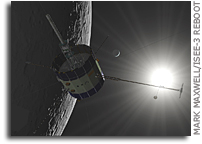 Ed Smith: As promised, the time of closest approach to the Moon is 18:16 UTC (on Sunday, 10 August). Vassilis Angelopolous at UCLA is now involved. He has two spacecraft in lunar orbit and is planning to acquire data during the ISEE flyby in a special telemetry mode. That should add immeasurably to the scientific results.
Ed Smith: As promised, the time of closest approach to the Moon is 18:16 UTC (on Sunday, 10 August). Vassilis Angelopolous at UCLA is now involved. He has two spacecraft in lunar orbit and is planning to acquire data during the ISEE flyby in a special telemetry mode. That should add immeasurably to the scientific results.
The telemetry signal continues to improve. There is still random telemetry noise but few if any long gaps so there is little disruption of the data and real signals are becoming clear. Don Gurnett’s team (SCH or Plasma Waves) recently reported seeing Auroral Kilometric Radiation from Earth, ion acoustic waves in the solar wind and electron plasma oscillations usually caused by a shock wave. They are debating whether they are seeing waves from Earth’s bow shock or an interplanetary shock.
The magnetometer data continue to look good. I believe I previously reported that we now see the sinusoids caused by spacecraft rotation. The agreement with ACE magnetometer data has improved and it is clearly evident that the ISEE VHM and ACE are seeing the same magnetic fields and variations. There are a series of Alfven waves present on 1 August between 15 and 19 hours. The waves involve turnings of the BZ (north-south) field southward especially a longish excursion of about an hour around 18 hours. That is usually the kind of event that can cause a substorm.
Bob Farquhar says Earth’s distant Magnetotail or wake will pass under ISEE on 30 September. The radial distance is about 10 x 10^6 km and the spacecraft will be about 2.4 x10^6 km above the ecliptic plane. That will probably make it hard to detect Tail fields as it is outside the Mach cone of the bow shock.
However, there may be surprises such as a disruption of the tail or something so we should probably look at any data available at that time. That’s all for now. As you can see, things are really picking up.
I hope you are recovering your data by now so you can join the fun.